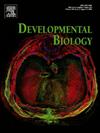Slit-independent guidance of longitudinal axons by Drosophila Robo3
IF 2.5
3区 生物学
Q2 DEVELOPMENTAL BIOLOGY
引用次数: 0
Abstract
Drosophila Robo3 is a member of the evolutionarily conserved Roundabout (Robo) receptor family and one of three Drosophila Robo paralogs. During embryonic ventral nerve cord development, Robo3 does not participate in canonical Slit-dependent midline repulsion, but instead regulates the formation of longitudinal axon pathways at specific positions along the medial-lateral axis. Longitudinal axon guidance by Robo3 is hypothesized to be Slit dependent, but this has not been directly tested. Here we create a series of Robo3 variants in which the N-terminal Ig1 domain is deleted or modified, in order to characterize the functional importance of Ig1 and Slit binding for Robo3's axon guidance activity. We show that Robo3 requires its Ig1 domain for interaction with Slit and for proper axonal localization in embryonic neurons, but deleting Ig1 from Robo3 only partially disrupts longitudinal pathway formation. Robo3 variants with modified Ig1 domains that cannot bind Slit retain proper localization and fully rescue longitudinal axon guidance. Our results indicate that Robo3 guides longitudinal axons independently of Slit, and that sequences both within and outside of Ig1 contribute to this Slit-independent activity.

果蝇Robo3纵轴突的裂隙独立引导。
Drosophila: Robo3是进化保守的Roundabout (Robo)受体家族的一员,也是Drosophila Robo的三个同类之一。在胚胎腹侧神经索发育过程中,Robo3不参与典型的裂缝依赖中线排斥,而是调节沿中外侧轴特定位置的纵向轴突通路的形成。据推测,Robo3的纵向轴突引导依赖于狭缝,但这尚未得到直接测试。在这里,我们创建了一系列的Robo3变异,其中n端Ig1结构域被删除或修改,以表征Ig1和Slit结合对Robo3轴突引导活性的功能重要性。我们发现Robo3需要其Ig1结构域与Slit相互作用,并在胚胎神经元中进行适当的轴突定位,但从Robo3中删除Ig1仅部分破坏纵向通路的形成。具有修改Ig1结构域的Robo3变体不能结合Slit,保留了适当的定位并完全恢复了纵向轴突的引导。我们的研究结果表明,Robo3独立于Slit引导纵向轴突,并且Ig1内外的序列都有助于这种独立于Slit的活性。
本文章由计算机程序翻译,如有差异,请以英文原文为准。
求助全文
约1分钟内获得全文
求助全文
来源期刊

Developmental biology
生物-发育生物学
CiteScore
5.30
自引率
3.70%
发文量
182
审稿时长
1.5 months
期刊介绍:
Developmental Biology (DB) publishes original research on mechanisms of development, differentiation, and growth in animals and plants at the molecular, cellular, genetic and evolutionary levels. Areas of particular emphasis include transcriptional control mechanisms, embryonic patterning, cell-cell interactions, growth factors and signal transduction, and regulatory hierarchies in developing plants and animals.
 求助内容:
求助内容: 应助结果提醒方式:
应助结果提醒方式:


